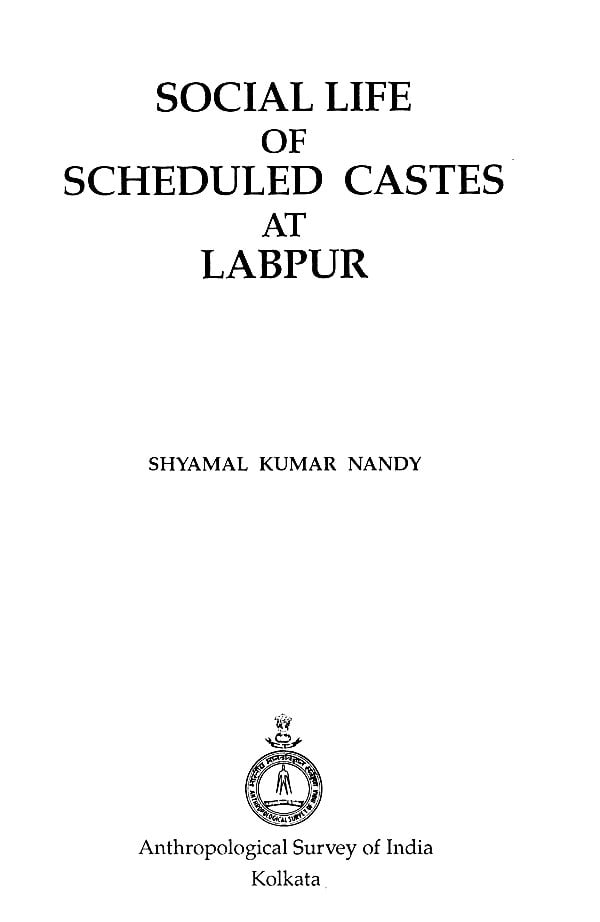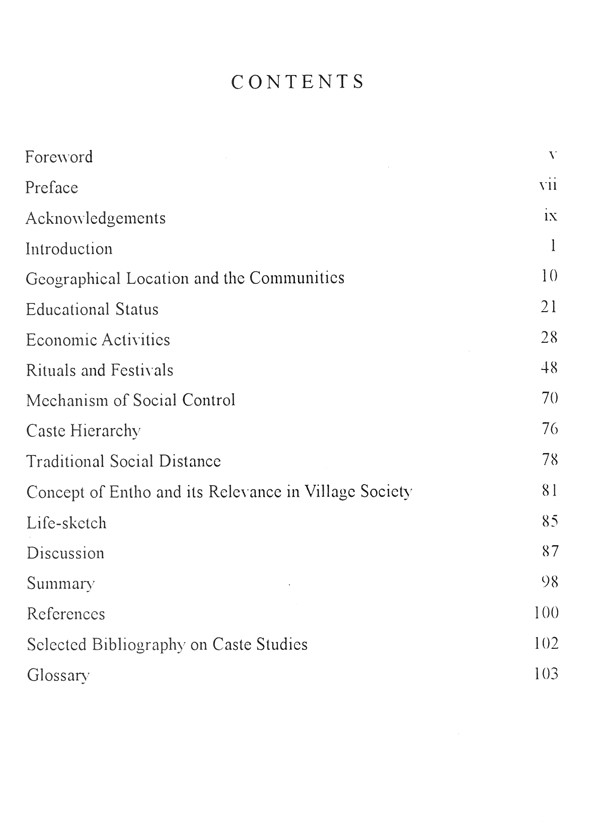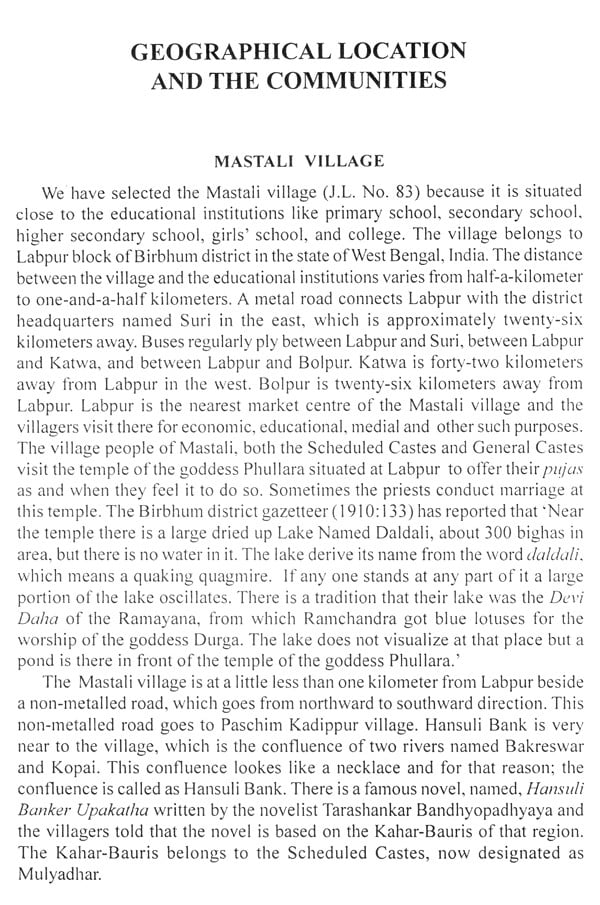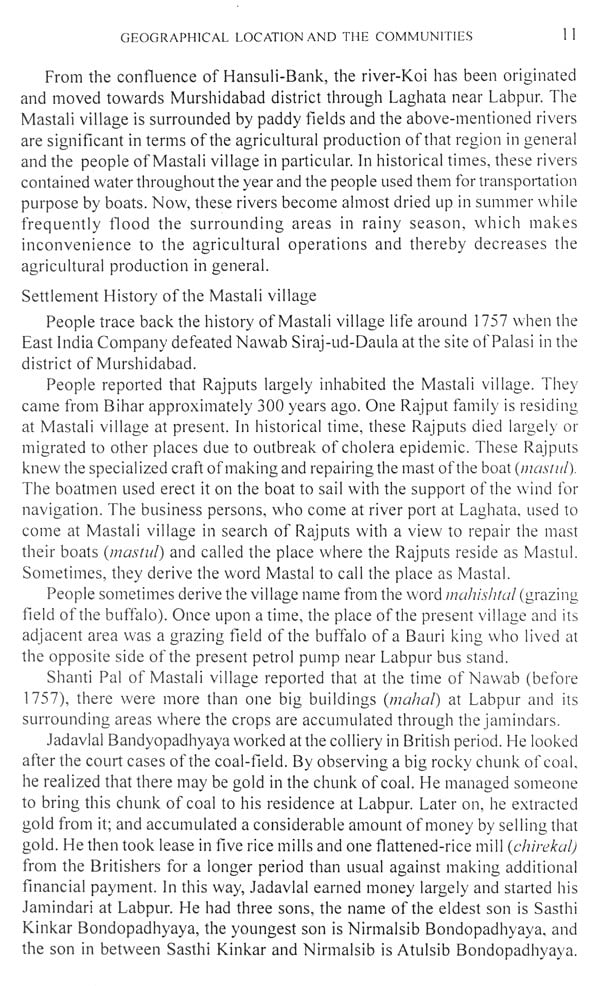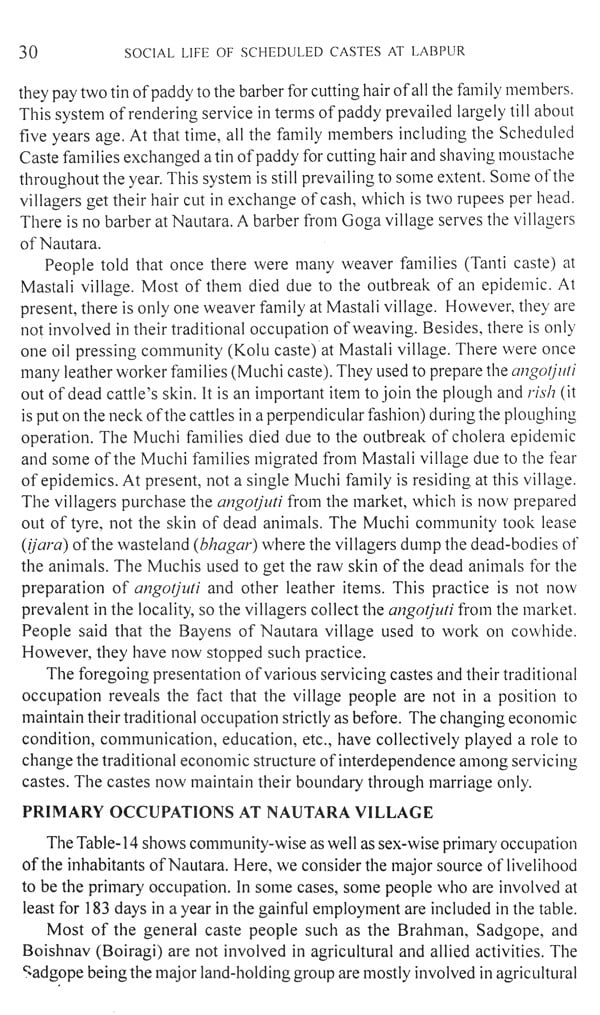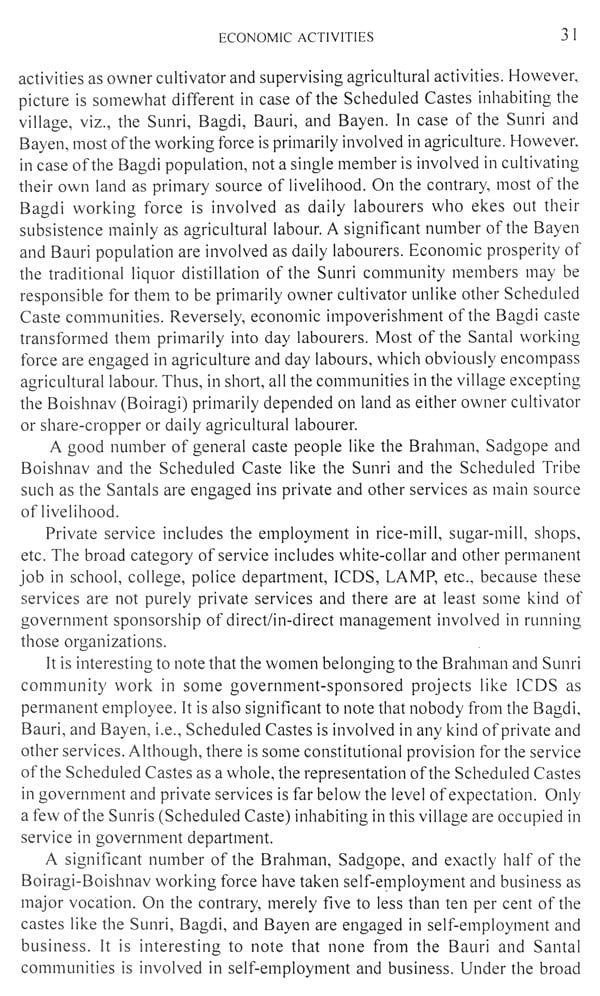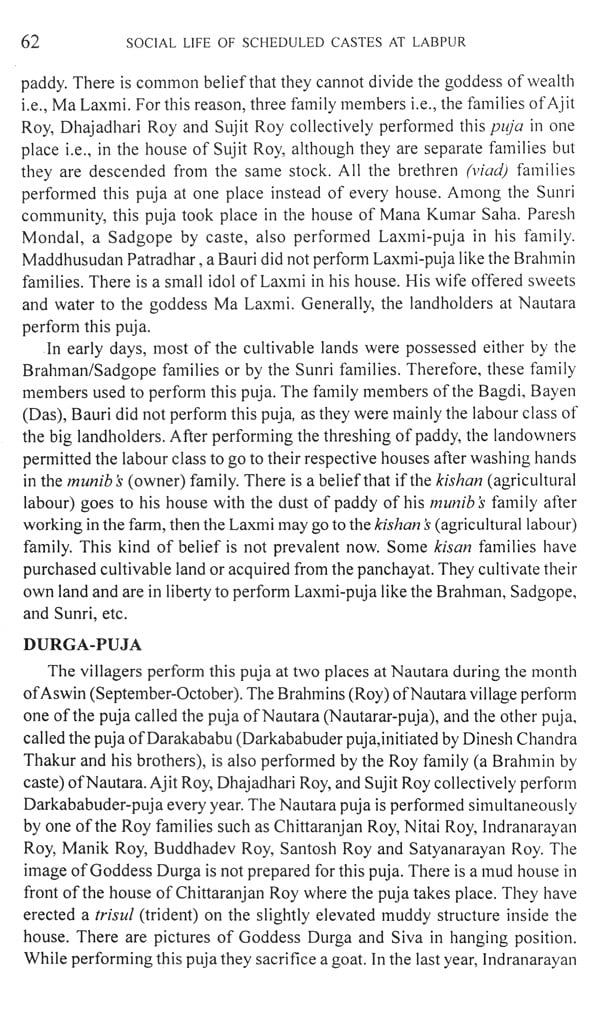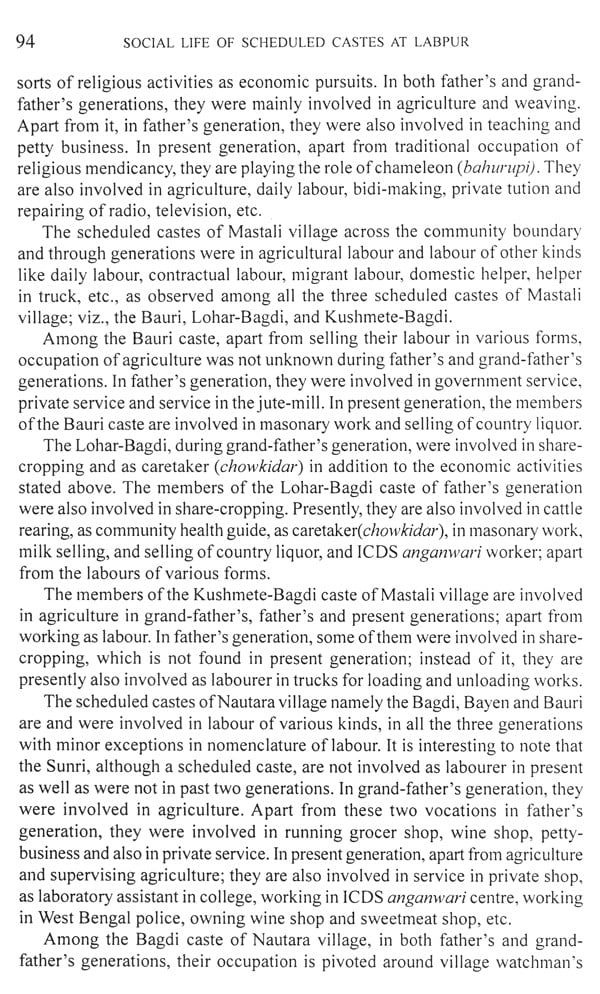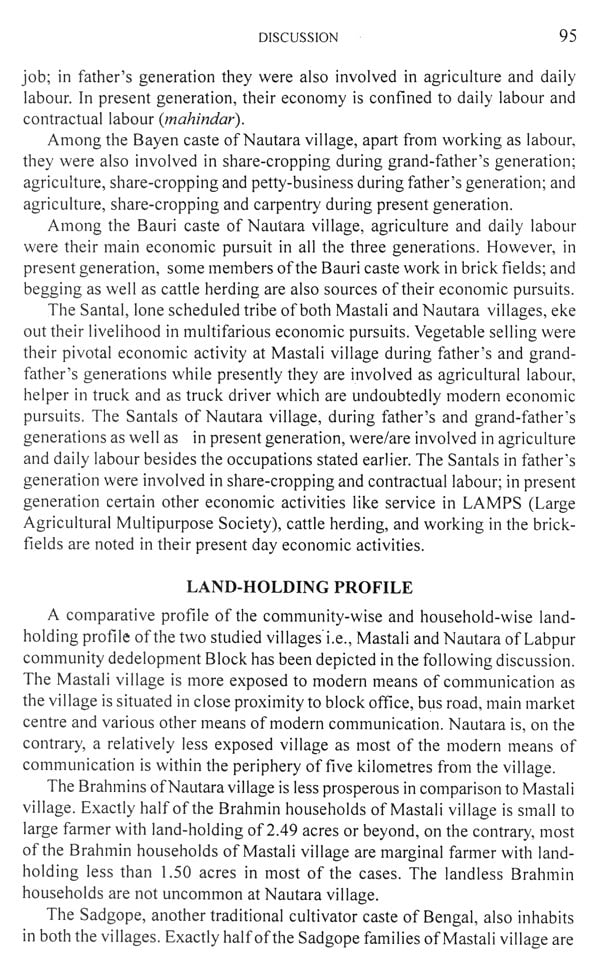
Social Life of Scheduled Castes at Labpur
Book Specification
| Item Code: | UBF204 |
| Author: | Shyamal Kumar Nandy |
| Publisher: | Anthropological Survey of India, Kolkata |
| Language: | English |
| Edition: | 2012 |
| ISBN: | 9789382984047 |
| Pages: | 115 |
| Cover: | PAPERBACK |
| Other Details | 9.50 X 6.50 inch |
| Weight | 230 gm |
Book Description
This book is based on intensive fieldwork of two villages in Labpur block of Birbhum -a district of West Bengal, India. Main emphasis has been given on the Scheduled Castes living in these two villages with reference to their occupational diversities. educational status, social life, life-sketches, rituals and festivities, and so on. A comparative account between the Scheduled Castes and General Castes as well as between the Scheduled Castes of two villages has dealt with the changing social scenario due to various exogenous and endogenous factors.
Shyamal Kumar Nandy (b. 1958) obtained Ph. D. in Anthropology from the University of Calcutta. Dr. Nandy joined Anthropological Survey of India, Government of India, in the year 1986 and presently holding the post of Research Associate in Cultural Anthropology. Dr. Nandy has rendered several years of research in Medical Anthropology under the guidance of Professor D. P. Mukherjee. Dr. Nandy also worked under the guidance of Professor B. K. Roy Burman. Besides, Dr. Nandy is a Life Member of The Asiatic Society and was an Invited Member of The New York Academy of Sciences.
The book titled "Social Life of Scheduled Castes at Labpur" is the outcome of an in-depth field investigation of two villages at Labpur block in the district of Birbhum, West Bengal; under the National Project "Study of Scheduled Caste: Structure and Transformation" launched by the Anthropological Survey of India in the year 1999.
The structure of a society as referred by T. B. Bottomore is "a certain order. a specific interconnectedness of the diverse elements, or spheres, of social life". He also suggested "the idea of social structure as a changing reality produced by processes of destructuration and restructuration". Bottomore's image of social structure refers to an underlying substructure abstracted from observable social life.
Social life of the scheduled castes, under this study, has revealed some interesting facts in terms of change and transformation in general since time immemorial due to the impact of the changing educational, political as well as occupational features, which have been working in the life and culture of the Scheduled Castes. The changes in the life-activities of the studied Scheduled Castes found to be not uniform yet there are good number of similarities if synchronically and diachronically viewed. The changing factors are endogenous and exogenous in nature. Social tradition, education, occupation and political services are the endogenous factors whereas exposure beyond the village life through well-connected communication system and the intervention of current information and knowledge through media are the exogenous factors. After considering these two factors, the units of this study was selected. One of the units of study is the village named as Mastali, which is in close proximity of the block headquarters, Labpur and is associated with market centre, and communication network. The other unit of the study is Nautara village, which is situated at a distance of six kilometres from the block headquarters and is devoid of any regular bus services to connect the village to the block headquarters and the market centre.
The observations on these two villages have been presented in this book as a methodological orientation to look into the social life of the scheduled castes. sometimes in a comparative outlook but not always. The observation is mainly based on qualitative outlook which is supplemented by the quantitative interpretation on educational status, occupational status, and land-holding pattern.
Scheduled Castes or Dalits in India have been subjected to social discrimination for centuries due to the status assigned to them in the Hindu social order, despite the constitutional protection granted to them by the Indian union after Independence. This is mostly due to the stigma attached to the Scheduled Castes within the ambit of caste hierarchy. Although there have been some improvement in their social standing and way of life in recent times. freedom of leading a life of dignity and freedom from hunger and ignorance are still elusive for many of them. In order to assess the prevailing social standing of the Scheduled Castes, the Anthropological Survey of India launched a plan project entitled "Study of Scheduled Castes: Structure and Transformation" sometimes back. The project was assigned to Dr. S. K. Nandy and was asked to take up two villages of Labpur block in Birbhum district of West Bengal to empirically assess the social life of the Scheduled Castes there.
Dr. Nandy, in this study, has objectively covered the geographical location. the communities, their educational status, economic activities, rites and rituals, mechanism of social control, caste hierarchy, traditional social distance, concept of Ethos and its relevance in village society, and life-sketches of the Scheduled Castes of Labpur, followed by discussion and summary. To sum up, the study covers the social position of the Scheduled Castes in the study villages vis-à- vis other caste populations. As anticipated, Dr. Nandy has concluded with a grim picture of the Scheduled Castes and the way in which they are struggling hard economically as well as socially for their betterment.
Social life depends and revolves on social relationships within the societies. The nature of social relationships is based on certain structural arrangements of social processes which going on to achieve the goals for survival within the society. Such processes have elasticity to accommodate many new things. keeping aside the old attitudes and behaviours of the people living in a particular society. As such, the old attitudes within the society may be changed totally by dint of general educational advancement, economic advancement, experiences of life-activities and exposure to the outer world, etc.
There are many social groups in the form of castes within the 'Scheduled castes'. Neither these castes are alike in terms of social, economic and educational statuses, nor they perform same type of social relationships with the other members of the Scheduled Castes and General Castes. These types of relationships are governed by the traditional notions which are going on generation after generation. The economic, political as well as educational factors have played a role in the existing social life of the village societies in general and the caste societies in particular. In some cases, the political leadership has come up from the Scheduled Castes which have helped them to protect their social position or even upliftment to a higher plane. The economically as well as educationally well off Scheduled Castes may have a dominance over others in the village societies where the traditional notions are breaking down and the attitudes are changing faster than ever. But, the members of the older generations sometimes are playing as a stumbling block in the attitudinal aspects of both the Scheduled Castes and General Castes. New educated females at present are having broader outlook and emphasizing on the cleanliness aspect as a key factor to maintain the social distance than the members of earlier generations. In such process the social distances between the communities have minimized to a great extent.
The term caste refers to the notion or ideology of social stratification of Indian society. In short, caste is defined as a form of social stratification that involves a system of hierarchically ranked, closed, endogamous strata, the membership of which is ascribed and between which contact is restricted and mobility is theoretically impossible. Although it reflects economic inequality. by virtue of occupation followed by members of different castes, caste stratification is ultimately rooted in non-economic criteria. Among the Hindu in India, the caste principle is religious in its purest form. Castes are ascribed in accordance with their degree of 'ritual purity' (Dumont 1970).
Dr. Nandy has made a very significant contribution to the study of Scheduled Castes in the present volume, for which I congratulate him for his honest efforts.
**Contents and Sample Pages**
